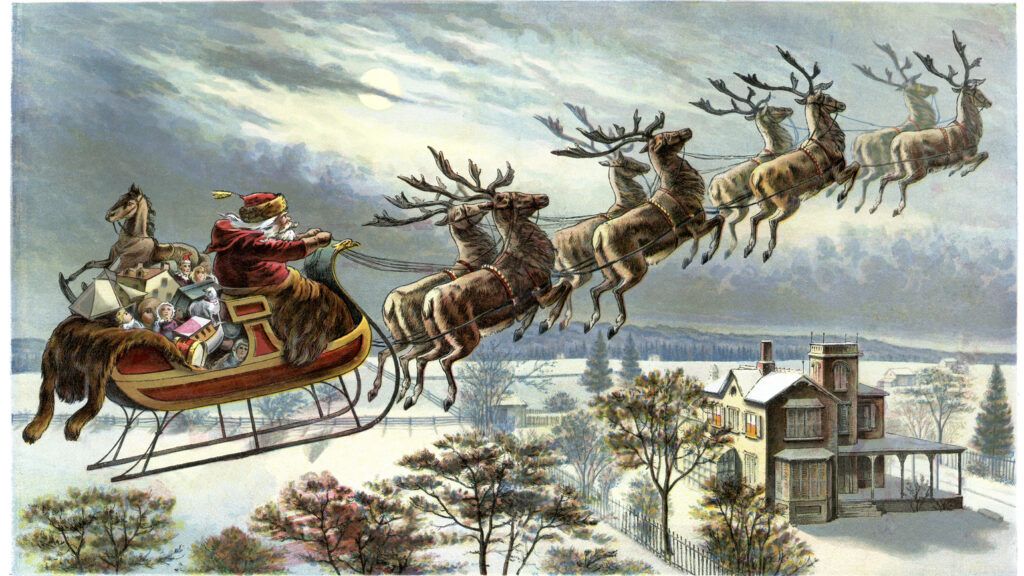Anyone who celebrates Christmas knows about the large jolly man dressed in red who flies on a sleigh and brings presents down a chimney. But why is he a part of our Christmas celebrations? What is the history of Santa Claus?

The Origin of Santa Claus: Saint Nicholas, a Man of Faith
The lovable Christmas figure Santa Claus is based on a real person: Saint Nicholas.
Nicholas of Myra was born sometime in the 4th century (his birthday is unknown) in present day Turkey, according to Britannica. After his parents were killed by illness, Nicholas donated all his wealth to the needy and dedicated his life to serving God. He was appointed bishop of Myra when he was still young because of his devotion to God and following the word of Jesus.
Bishop Nicholas was a man of deep faith. At one point he took a pilgrimage to the Holy Land to walk in the steps of Jesus and better understand Him. During his life, he was prosecuted as a Christian and even imprisoned. Yet he did not let his belief waver. Despite his difficult life, he was known for his acts of generosity and performing miracles for people in need.
Nicholas died on December 6th 343 AD, states Britannica. After he was beatified as a saint, this date was chosen as his Saint’s Day. While most reports state he was buried at his church in Myra, there are some conflicting accounts of this. Historians believe his remains were removed at one point and taken to Bari, Italy. According to some legends, part of his remains were taken to Ireland by two soldiers who fought in the Crusades. In Newtown Jerpoint, Ireland, there is a grave slab that depicts Saint Nicholas with two soldiers.
READ MORE: 5 More Things to Know About the Saint Behind Santa Claus
Saint Nicholas’ Miracles
Nicholas performed various miracles throughout his life. Some of these miracles were confirmed by the church and used as proof for his beatification. Because of these divine deeds, Saint Nicholas is the patron saint of children and sailors. Here are some of the major miracles of Saint Nicholas, during his life and even after his death:
- Healing a woman’s hand
- Making dowry money appear for three poor sisters in the socks they hung drying above their fireplace (this is where the history of Christmas stockings originated)
- Resurrecting three boys who were murdered
- Calming a storm at sea and saving the ship he was on
- Saving a young boy who was kidnapped by pirates
- Appearing on ships that were in danger and providing aid
READ MORE: 10 True Christmas Miracles to Comfort Us

The History of the Modern-Day Santa Claus
As time went on and the Protestant faith grew, devotion for Saint Nicholas subsided. He remained popular in Holland, where he was known as Sinterklaas. But how did we get to the Santa Claus we know today?
READ MORE: Santa Claus Around the World
For that we can thank American writer Washington Irving, best known for writing the classic Halloween short story “Sleepy Hollow.” He had a hand in not just making Saint Nicholas popular again, but also popularizing the idea of celebrating Christmas in America. His goal was to make Christmas a time of giving and community. In 1819, he wrote in one of his many books, “Christmas is a season for kindling the fire for hospitality in the hall, the genial flame of charity in the heart.”
Because of Irving’s writing, other writers and artists felt inspired by the selflessness of Saint Nicholas and included him in their own writing and art.
In 1822, poet Clement Clarke Moore wrote a poem for his three children titled “An Account of a Visit from St. Nicolas,” though it is more commonly known by its first line, “‘Twas the Night Before Christmas.” This poem, now one of the most popular ever written, depicts many of the Santa Claus characteristics we know today. A joyous man with a round belly, a sack of toys, a sleigh pulled by reindeer, and that famous final line, “Happy Christmas to all, and to all a good night!”
In 1863, this Santa Claus finally had an image to go along with it. Cartoonist Thomas Nast published his drawing of Santa Claus on the cover of Harper’s Weekly. L Frank Baum, the author of The Wizard of Oz, added his own spin on Santa Claus in 1902 with his book, “The Life and Adventures of Santa Claus.”
READ MORE: 8 Classic Christmas TV Specials We Love
Then in 1931, according to their website, the Coca-Cola company hired artist Haddon Sundblum to paint a picture of Santa Claus for a Christmas advertisement. This smiling Santa Claus, with his red suit, rosy cheeks and a white beard, became so popular, it is the Santa most of us picture today.

Does Santa Claus Belong in Christmas?
But if our modern idea of Santa Claus is partially based on a soda advertisement, does he really belong in Christmas celebrations? Despite the commercialization of this figure, he is still based on Saint Nicholas, a real man of faith and generosity.
“Gift-giving, stockings hung by the chimney with care, Santa coming down the chimney, the joy of seeing your kids and grandkids unwrap a toy under that well-lit tree,” said Guideposts contributor Rick Hamlin. “They all feel connected to Christ’s eternal message of love.”




